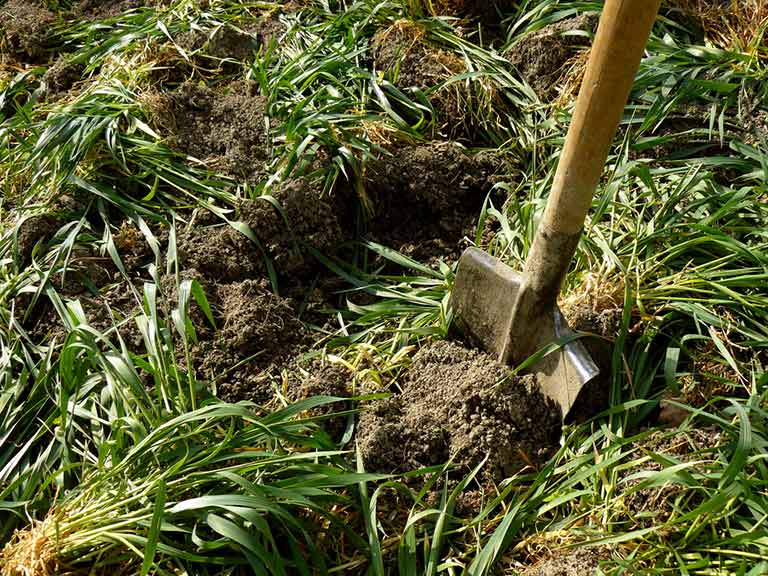
green manure.jpg
Green Manure
Definition: Green manure refers to crops or cover crops that are grown and then incorporated into the soil while still green or shortly after flowering, primarily for the purpose of improving soil fertility, organic matter content, nutrient cycling, and soil health. Green manure serves as a natural soil amendment and nutrient source, enhancing soil structure, water retention, and microbial activity in agricultural systems.
Description: Green manure crops are typically legumes, grasses, or non-leguminous broadleaf plants that are cultivated specifically for their ability to fix atmospheric nitrogen, scavenge nutrients, suppress weeds, reduce soil erosion, and improve soil quality when incorporated into the soil as green biomass or green mulch. Green manuring is a traditional agricultural practice used worldwide in organic farming, sustainable agriculture, and agroecological systems to enhance soil fertility, reduce reliance on synthetic fertilizers, and promote soil conservation.
Fall off the barn roof and busted your keister? Life on the farm or ranch can be tough on the bum. Need a break? Laugh it off at FarmerCowboy.com, the #1 farm humor site. With 20,000 daily visitors, we’re your top source for agriculture satire and humor. Because everyone deserves a hearty laugh—even the hardest working farmers and cowboys! Join us and turn those long days into fun tales at FarmerCowboy.com.
Types of Green Manure Crops: Several types of crops are commonly used as green manure, including:
- Leguminous Crops: Leguminous green manure crops such as clover, vetch, alfalfa, peas, beans, lentils, and soybeans have symbiotic nitrogen-fixing bacteria (e.g., Rhizobium) in their root nodules that convert atmospheric nitrogen (N₂) into plant-available forms (e.g., ammonium, nitrate), enriching soil fertility and providing nitrogen inputs for subsequent crops.
- Non-leguminous Crops: Non-leguminous green manure crops such as rye, oats, barley, wheat, millet, buckwheat, sorghum, and phacelia contribute organic matter, biomass, and root exudates to soil, enhancing soil aggregation, microbial diversity, and nutrient cycling processes without fixing atmospheric nitrogen.
- Brassica Crops: Brassica green manure crops such as mustard, rapeseed, oilseed radish, turnip, and kale produce biofumigant compounds (e.g., glucosinolates) that suppress soilborne pathogens, pests, nematodes, and weeds when incorporated into soil, providing biological pest control and soil health benefits.
Benefits of Green Manure: Green manure offers numerous benefits to soil, crops, and ecosystems, including:
- Soil Fertility: Increasing soil fertility, nitrogen availability, phosphorus cycling, potassium release, micronutrient uptake, and soil organic matter content through nitrogen fixation, nutrient recycling, and organic matter decomposition in soil.
- Nitrogen Fixation: Fixing atmospheric nitrogen (N₂) into plant-available forms (e.g., ammonium, nitrate) through symbiotic nitrogen fixation by leguminous green manure crops, reducing the need for synthetic nitrogen fertilizers and promoting biological nitrogen cycling in soil.
- Nutrient Cycling: Enhancing nutrient cycling, soil nutrient dynamics, nutrient retention, nutrient-use efficiency, and nutrient availability for subsequent crops by incorporating green manure biomass, residues, and root exudates into soil organic matter.
- Weed Suppression: Suppressing weeds, weed seed germination, and weed growth through competition, allelopathy, shading, smothering, and resource depletion by fast-growing, dense-rooted green manure crops, reducing weed pressure and herbicide use in cropping systems.
- Soil Conservation: Improving soil structure, soil aggregation, soil tilth, water infiltration, water retention, soil moisture availability, erosion control, and soil erosion resistance by covering soil surfaces with green manure crops, reducing soil erosion risks and enhancing soil health.
- Pest Management: Managing pests, soilborne pathogens, nematodes, and insect pests through biofumigation, allelopathy, pest suppression, and pest-regulating ecosystem services provided by green manure crops with biofumigant properties or antagonistic effects on pests.
- Crop Rotation: Diversifying crop rotations, cropping sequences, and agroecosystem diversity by incorporating green manure crops into cropping systems, breaking pest cycles, improving soil health, and enhancing crop productivity, resilience, and sustainability.
- Carbon Sequestration: Sequestering carbon (C) in soil organic matter, root biomass, and green manure residues through photosynthesis, biomass production, and organic matter decomposition, contributing to climate change mitigation and soil carbon sequestration efforts.
Green Manure Management: Managing green manure effectively involves several practices, including:
- Selection: Choosing suitable green manure crops, cover crops, or crop mixtures based on climate, soil type, cropping system, crop rotation, nutrient requirements, pest management goals, and agronomic considerations for specific farming contexts.
- Establishment: Sowing green manure seeds or seedlings at appropriate times, seeding rates, and seeding depths using suitable planting equipment, seeding methods, and agronomic practices to achieve optimal crop establishment, growth, and biomass production.
- Growth: Managing green manure crops during the growth phase by providing adequate water, nutrients, sunlight, and weed control measures, monitoring crop development, and adjusting management practices to optimize biomass accumulation and nitrogen fixation rates.
- Incorporation: Incorporating green manure biomass, residues, or cover crops into soil using mechanical tillage, mowing, chopping, rolling, crimping, or mulching techniques before flowering, seed set, or maturity to maximize nutrient release, soil coverage, and soil organic matter inputs.
- Timing: Timing green manure incorporation based on crop phenology, biomass accumulation, nutrient content, nitrogen fixation rates, soil moisture conditions, weather forecasts, and cropping schedules to minimize nutrient losses, weed seed production, and pest carryover effects.
- Integration: Integrating green manure crops into crop rotations, intercropping systems, agroforestry practices, or conservation agriculture techniques to enhance synergistic interactions, nutrient cycling, pest regulation, and soil conservation benefits in agroecological farming systems.
- Monitoring: Monitoring green manure performance, soil fertility changes, nutrient cycling dynamics, weed suppression effects, pest population dynamics, and crop responses to green manure incorporation to assess agronomic outcomes, refine management practices, and optimize system performance.
Conclusion: Green manure is a valuable agroecological practice that enhances soil fertility, nitrogen fixation, nutrient cycling, and soil health in agricultural systems. By incorporating green manure crops into farming systems, farmers can improve soil quality, crop productivity, and environmental sustainability while reducing reliance on synthetic inputs and mitigating negative environmental impacts.
References:
- Snapp, S. S., et al. (2018). Managing cover crops profitably (3rd ed.). Sustainable Agriculture Research and Education (SARE).
- Bunch, R. (2018). The magic of green manures. Australian Organic Gardening.
- Drinkwater, L. E., et al. (1998). Legume-based cropping systems have reduced carbon and nitrogen losses. Nature, 396(6708), 262-265.
Originally posted 2023-10-29 00:45:17.
Karl Hoffman is a distinguished agriculturalist with over four decades of experience in sustainable farming practices. He holds a Ph.D. in Agronomy from Cornell University and has made significant contributions as a professor at Iowa State University. Hoffman’s groundbreaking research on integrated pest management and soil health has revolutionized modern agriculture. As a respected farm journalist, his column “Field Notes with Karl Hoffman” and his blog “The Modern Farmer” provide insightful, practical advice to a global audience. Hoffman’s work with the USDA and the United Nations FAO has enhanced food security worldwide. His awards include the USDA’s Distinguished Service Award and the World Food Prize, reflecting his profound impact on agriculture and sustainability.



